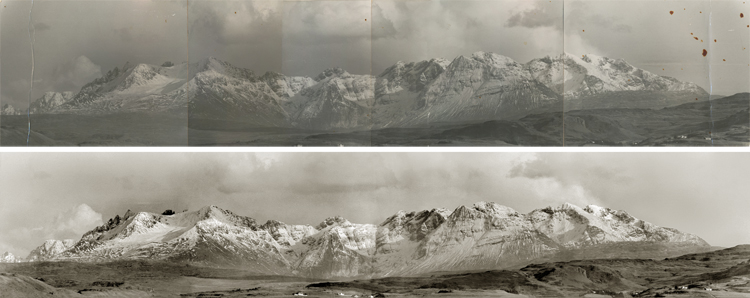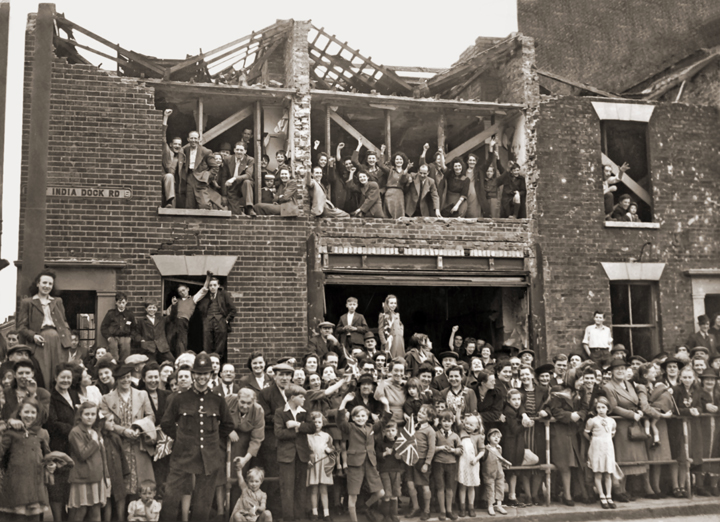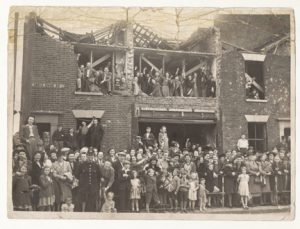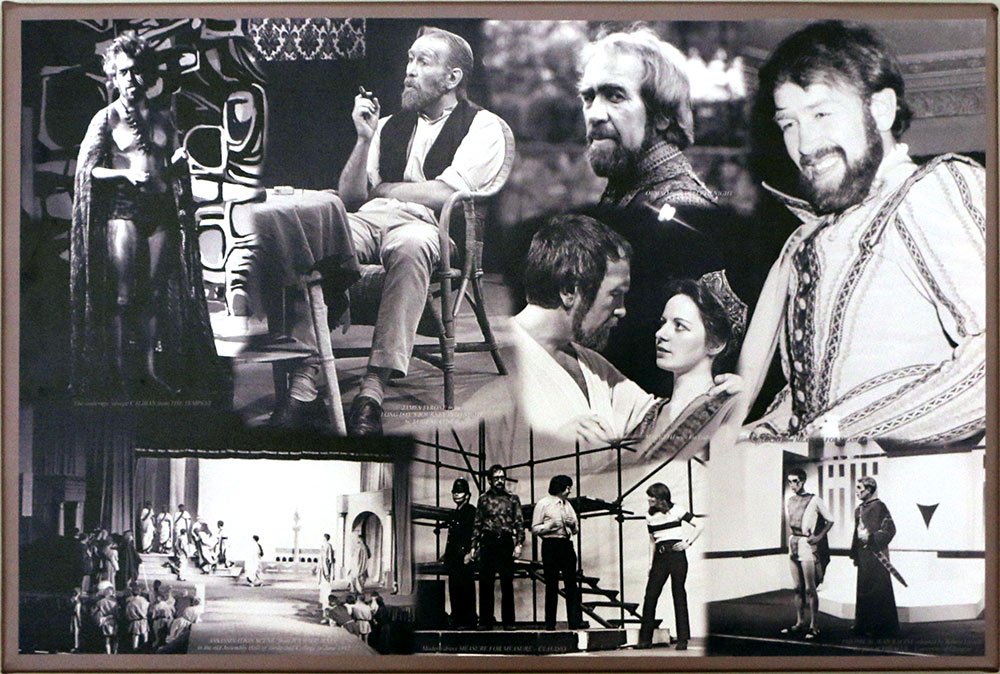This fantastic photograph of a Victor V Bomber refueling English Electric Lightnings over the Niagara Falls is one that I had the pleasure to restore and colourise recently. I found the correct colouring of all the aircraft from technical drawings I found on Google Images.
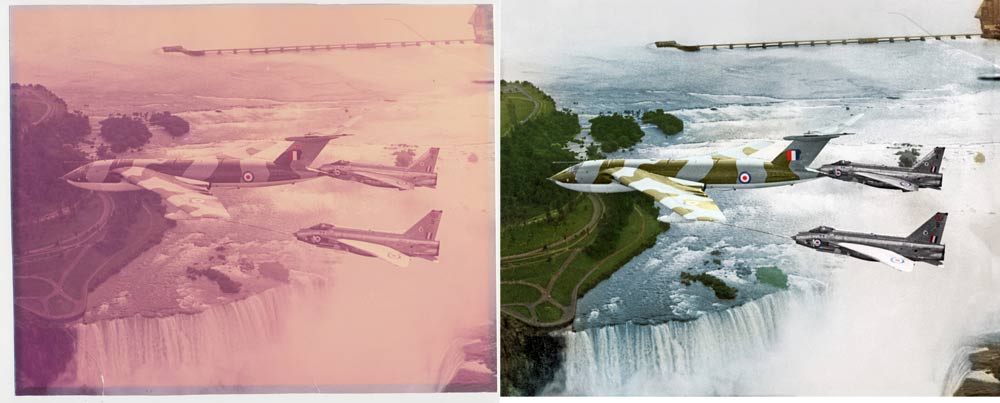
No Risk Photograph Restoration - Free Advice Call 01825 740986
Archive for photo restoring – Page 5
I received this photograph as four photographs stuck together and folded as that was the best way with the technology of the time. When it was restored I printed a 40inch wide print.
Here’s the story….
“The Cuillins is a range of rocky mountains located on the Isle of Skye, we spent many happy family holidays on Skye when I was a child and my Dad, George Smith who was a very talented amateur photographer, spent years perfecting his panorama of “the Cuillins” as we used to call them, he unfortunately passed away in 2015 and we recently went through some of the many images he had painstakingly crafted over the years, including this one which was in fairly bad condition having been folded up & stored in a box in a damp sitting room in a French Farmhouse for the last 10 years; I love this image as it brings back so many wonderful memories of my Dad and the fun we used to have on Skye in the shadow of the Cuillin, I am so grateful to Richard for the amazing restoration and for enabling such a precious memory to be recovered and displayed once again in its full glory.”
My customer Karen E tells the story of this (now restored) photograph
“This photograph was taken on a day when King George VI and Queen Elizabeth visited Poplar during the Blitz. My father as a boy is standing in the right upper window with his mum on his right and his best friend beside him.
My father remained in Poplar throughout the war with his father who was a stevedore in the docks and his mother who was a seamstress. Their house suffered damage in the war when an incendiary device came through the roof and landed on his parent’s bed, luckily it did not ignite and they managed to wrap it in the bedding and throw it out of the window!”
Here’s the original photograph I received:
I recently received an order from Iain Anderson from Renfrewshire as he wanted me to produce a montage on canvas of some his photographs taken when he was in various dramatic stage roles.
During our conversations I found that Iain has his own radio show on BBC Scotland and he plays some really great music, much of which you may not have heard before and is well worth hearing, which you can hear again on the BBC iPlayer.
Click on his photograph below for the link to listen
We all have old photographs that we treasure, whether they are old family photographs passed on from previous generations, or historic photographs of the homes and towns we live in.
Photographs are the best tool we have to relive our cherished memories and remember loved ones who are no longer with us. Unfortunately photographs don’t age well and over time their quality diminishes.
Because photos are printed on paper things such as handling, light, moisture, dust, and scratches often affect them. Regrettably, these things can ruin our photos and prevent them from lasting through the generations.
Most of the photo papers and inks used up until recently have not been archival quality, and as a result, many photo prints show signs of fading and colour shifts after only a few years.
Poor storage practices such as keeping photos in attics or basements or allowing photos to be exposed to sunlight, have also contributed to the poor condition of most photo collections.
People don’t realize there is a problem until they take a look at their photo collection after many years of storage. Our precious photo collections are in fact fading away and in time many will be beyond recovery. There is also the possibility of their demise in the case of fire or flood.
It is a good idea to restore your special photographs or even entire photo collection in order to stop the unavoidable destruction that will take place no matter how carefully the photos are stored. Once restored, the photos can be copied to CD or DVD for long-term storage and safekeeping. Once you have digital copies you needn’t worry about further damage because digital images do not change at all. You can use these digital images to make a set of prints on archival paper, which will last over 100 years in an album with no signs of degradation or twenty years exposed to daylight for framed prints. Additional prints can be made at any time in the future should disaster strike. You can also share the images with other members of your family and friends.
During the restoration process it is also possible to improve the quality of the original photograph – for example removal of spots, stains, marks, tears as well as improving contrast, brightness, colour balance and enhance detail, focus and sharpness.
It is also possible to add colour to black and white photographs, as well as being able to make quality enlargements for framing.
Are you one of the many people who has hundreds or even thousands of photographs, some in albums, some in boxes, and in more recent years, huge numbers of digital photographs on the computer? The thought of organising all your precious family photographs can seem quite overwhelming although when it’s done there are huge advantages that make the job very worthwhile.
How good would it be to be able to find the photos you want, when you want them, and end the seemingly endless frustrating searches that we’ve all done in the past. More importantly, when your photographs are organised, future generations will have all the benefits of your efforts. They will know who is who, dates, places and any other detail you may be able to add. Your photograph archive becomes a valuable heirloom.
It’s Easier Than You Think
At first it may seem like a task that is just too enormous to tackle. The good news is that when it’s broken down into simple steps, it’s much easier than you think, is actually great fun and is very rewarding.
- Collect together all loose photographs and albums into one place
- Sort the photographs into as near chronological order as you can. During this process put aside any duplicates, sub-standard photographs and ones that you don’t like or are irrelevant.
- Scan all the remaining photographs to your computer. Use a scan resolution of 300 – 600 dpi so that any future prints made from the scan will be good quality. If you can’t do this yourself I can do this for you.
- Create a sub-folder for each year in the My Pictures folder of your computer and put the scanned images into the appropriate year’s folder. Where the year is not known just use your best estimate. To further refine this you can add a sub-folder in each Year folder using the date and subject. For example name the final folder 2013-10-15 Family Party. By using the date format with the year first this makes sorting the folders more logical.
- Picasa is a free program by Google that makes it very easy and straightforward to keep track of all your photographs. It will automatically find all the photographs on your computer and arrange them all in chronological order keeping the names of each folder. This will include all the digital photographs you already have on your computer.

- Apart from organising your photos you can also enhance them, crop them, and add different effects, although I would suggest you leave any editing until you have the photos organised. You can download Picasa free from http://picasa.google.co.uk/
- You can also title each photograph with further information about the people, places and any other information required.
- Tagging your photographs in Picasa is also a useful way to find what you want quickly. A tag is used for a type of photograph, for example ‘Home’. How this could work is that any photograph from any year that features your home could be tagged with the word ‘Home’. Other tags might be ‘Buildings’, ‘Holidays’ or anything else you choose.
- Picasa has great search capabilities. If you type in its search field any word relating to the name of a folder, sub-folder, title or tag it will instantly display all those photographs on your screen. Picasa also has a fantastic face recognition feature which work extraordinarily well. It recognises faces even in large group photos, makes a thumbnail image of just the face. You name each different face and it finds all the photographs with that persons face, at any age, and creates a thumbnail of the face against that person’s folder (automatically created). If it doesn’t get it right (rarely) you have the option to correct it. This is a very useful feature in family history projects.
Backing up Your Photographs For Safety
So now you have all your photographs in one place, you have named folders and photographs and they are easy to find. It’s important that you back them up. This can be done simply by copying the files onto a separate USB external hard drive, CD or memory stick or better still in the cloud on line. Livedrive (see www.livedrive.com) is an easy inexpensive cloud-based backup service – a small price to pay for security of all your precious photographs and any other information you need backed up.
Here is an interesting order I completed recently. Not only to combine two photographs that were in very poor condition but also to add the woman from the first photograph – minus baby! – to the second photograph while turning her around so she was facing the right way rather than turning her back on her husband!

This was the email I received from my customer…
“Well you’ve done it again, this time with knobs on and I am not referring to the door knob in one the photos! What an absolutely fantastic result. I appreciate the time and effort you must have put in to get the images of individuals in one photo transferred and included in another. The results to include the clean up and restoration are really brilliant, my great grandmother has literally “rejoined” her family – Fantastic. I can’t wait to present the final prints to members of my family.” John P
Many of my customers have told me how they’d had difficulty confronting the task of sorting out their photographs which have piled up over the years, so I hope you find this helpful.
I’ve found that once I actually start a job that has been difficult to face, it’s always much easier and quicker that I thought it would be and invariably I actually enjoy the process, getting a good sense of satisfaction when it’s all done.
For example if you like the idea of having modern photo-books that will last forever with no deterioration, no loose photographs falling out and also a book of the family photographs that your relatives can easily have their own copy of then read on…..


It’s easiest to break the project into smaller manageable stages….
- Gather all your photographs together into one place
- Make a specific time to sit and go through them to separate the worthwhile ones from the not so worthwhile/duplicates/irrelevant ones
- Put them into some kind of order – this is not critical as it’s very easy to change the order after scanning
- Have the selected photographs digitally scanned – these can be put into separate “folders” if required
- After scanning think about captions and or groups for the photos
- Work out a suitable order for your photographs to go into the new photo-book
- When your photo-book has been put together you will see a ‘virtual book’ on line for checking and approval
- Order your photo-book(s) – this can be the relevant size/number of pages to suit the photographs in question.You may find it easier to divide the photos into several smaller books to keep sections separate (dates/places/content)
If there are various family members interested in your project, it is often the case that the overall cost can be shared so each person gets a finished photo-book and the cost of production of the book split several ways.
I hope this is helpful – don’t hesitate to get in touch to discuss any aspect further or if you need any further information – I can help you at every stage.
I can also assure you that the final photo-book will be something that you’ll truly treasure and you’ll be so glad you went to the effort to get it made.
Here is a photograph I was asked to digitally restore. The original photograph is about a metre and a half wide and the photograph is absolutely fascinating as it contains so much detail. It’s a photograph of Robertson and Ginnetts Gigantic Circus at the British Empire Exhibition in Wembley Stadium in 1925 featuring my customer’s great grandfather who is the ringmaster!
Here is the whole photograph before restoration, after restoration and then a single detail followed by a detail of that detail! There are literally hundreds of recognisable faces.
Here are some other close-up sections going along the front row from left to right
The following is an extract from Anne Clendinning, “On The British Empire Exhibition, 1924-25″
The British Empire Exhibition, held in 1924 and 1925, assembled the member nations of the empire to develop imperial trade connections and to cultivate closer political ties between Britain and her territories.
The British Empire Exhibition opened for a second season in May 1925, but only after considerable debate. Despite the enthusiastic press reports and the self-congratulatory comments of the exhibition organizers, the 1924 exhibition was a financial disaster. Executive director Sir William Travers Clark blamed the cold, rainy summer. Although 17 million people had passed through the turnstiles, that figure was much lower than the anticipated 30 million visitors that had been the basis for 1924’s projected returns. If only to try and recoup its investment, the British government agreed to re-open Wembley in 1925.
More recently, the British Empire Exhibition appears in the 2010 film about the Duke of York’s stammer wherein Prince Bertie delivers a painful public address at the exhibition’s closing ceremony in October 1925.
There is another interesting article of the British Empire Exhibition here
Recent Posts
- Robin’s Solution to ‘Lest We Forget’
- The Appearance of John Kempster’s Photo Album of The Titanic
- Historic and Fascinating Circus Photograph at Wembley 100 Years Ago
- Original Photograph Restored and Enlarged Over 15x
- The Magic of Photograph Restoration – and a Perfect Gift
- The Fascinating History of Nutley Motor Services Premises
- A Picture Brought Back to Life: The Story of PC Austwick
- Photographs Forever – Truly a Family Business
- Jayne Shrimpton – ‘Photo Detective’ Since the 1980s
- Ancestry.com – The Perfect Place to Create Your Family History
Phone: 01825 740986
Email: info@photographsforever.co.uk
Hours: Mon-Fri: 9am-6pm
Address: Fairlight, Chelwood Gate, Beaconsfield Road, Haywards Heath, West Sussex, RH17 7LF
| Website Design by Profitable Websites |


